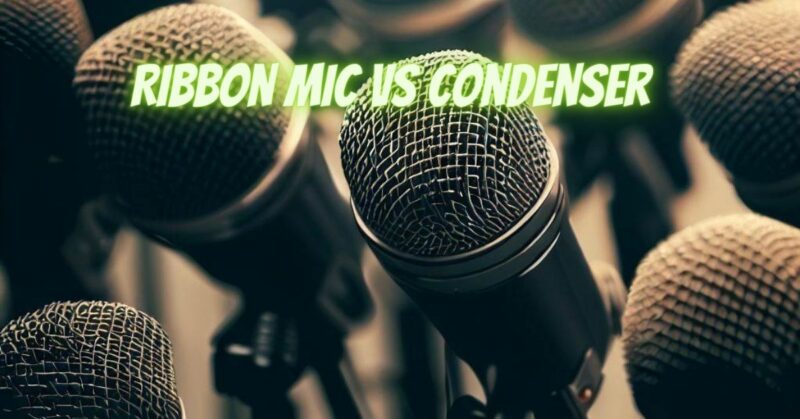When it comes to capturing sound in the world of professional audio recording, microphones play a crucial role. Among the diverse microphone types available, ribbon and condenser microphones stand out as popular choices, each offering unique characteristics and applications. In this article, we will delve into the distinctions between ribbon microphones and condenser microphones, shedding light on their design, sound qualities, and ideal use cases. Understanding these differences will help you make informed decisions when selecting the right microphone for your specific recording needs.
Ribbon Microphones: Ribbon microphones have a long-standing legacy in the audio industry, tracing their roots back to the early days of recording. They employ a thin, delicate ribbon element made of aluminum or other metallic material suspended between magnets. Key characteristics of ribbon microphones include:
- Natural and Vintage Sound: Ribbon microphones are renowned for their warm, smooth, and vintage sound reproduction. They excel at capturing the natural timbre and nuances of sound sources, making them a preferred choice for vocals, string instruments, and brass instruments.
- Figure-8 Polar Pattern: Most ribbon microphones employ a figure-8 polar pattern, capturing sound equally from the front and back while rejecting sound from the sides. This pattern allows for versatile recording techniques and is particularly useful for capturing duets or multiple sound sources facing each other.
- Excellent Transient Response: Ribbon microphones have exceptional transient response, capturing fast transients accurately. They are well-suited for recording dynamic and fast-paced musical performances, delivering an authentic representation of instrument attack and decay.
Condenser Microphones: Condenser microphones, also known as capacitor microphones, utilize a thin diaphragm that acts as one plate of a capacitor. The diaphragm’s movement in response to sound waves changes the capacitance, generating an electrical signal. Key characteristics of condenser microphones include:
- Extended Frequency Response: Condenser microphones offer a wide frequency response range, capturing a broad spectrum of sound frequencies with great detail. They are ideal for capturing intricate high-frequency content, making them suitable for capturing vocals, acoustic instruments, and capturing room ambience.
- Higher Sensitivity and Output: Condenser microphones are generally more sensitive than ribbon microphones, producing higher output levels. This sensitivity allows them to capture subtle details and nuances in sound sources, making them a go-to choice for studio recordings and situations where capturing fine details is essential.
- Power Requirements: Condenser microphones require power to operate their internal electronics and charge the capacitor. This power can be provided through batteries, external power supplies, or phantom power from audio interfaces or mixers. It’s important to ensure the availability of power when using condenser microphones.
| Feature | Ribbon Microphones | Condenser Microphones |
|---|---|---|
| Sensitivity | Very sensitive | More sensitive than dynamic microphones |
| Frequency response | Wide frequency response | Wider frequency response than dynamic microphones |
| Clarity | Smooth, warm sound | Clear, detailed sound |
| Price | More expensive | Less expensive |
| Power requirements | Do not require phantom power | Require phantom power |
| Susceptibility to feedback | More susceptible to feedback | Less susceptible to feedback |
Choosing the Right Microphone: Selecting between ribbon and condenser microphones depends on several factors, including the desired sound character, application, and environmental considerations. Here are a few general guidelines:
- Ribbon microphones are well-suited for capturing vintage, warm, and smooth sounds. They shine in recording sessions that prioritize natural timbre, vintage aesthetics, and instruments with a softer or more delicate character.
- Condenser microphones excel at capturing detailed and accurate sound reproduction across a wide frequency range. They are often the preferred choice for studio recordings, capturing vocals, acoustic instruments, and situations that require capturing fine details and high-frequency content.
Ultimately, the choice between ribbon and condenser microphones comes down to personal preference, the specific sound you want to achieve, and the nature of the recording project at hand.
Conclusion:
Ribbon and condenser microphones each offer distinctive qualities that cater to different recording scenarios. Ribbon microphones provide a vintage and warm sound character, excellent transient response, and a figure-8 polar pattern. On the other hand, condenser microphones offer extended frequency response, high sensitivity, and the ability to capture intricate details. By understanding their differences, you can make informed decisions when selecting the right microphone for your specific recording needs, ensuring optimal sound capture and sonic excellence in your audio projects.


